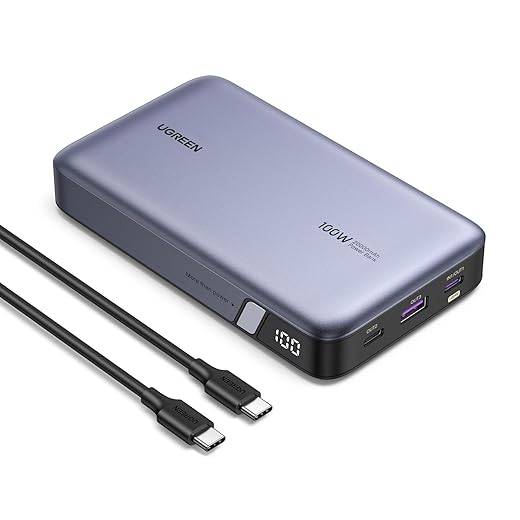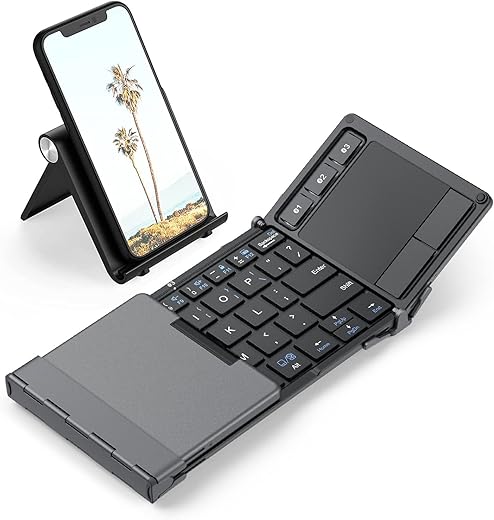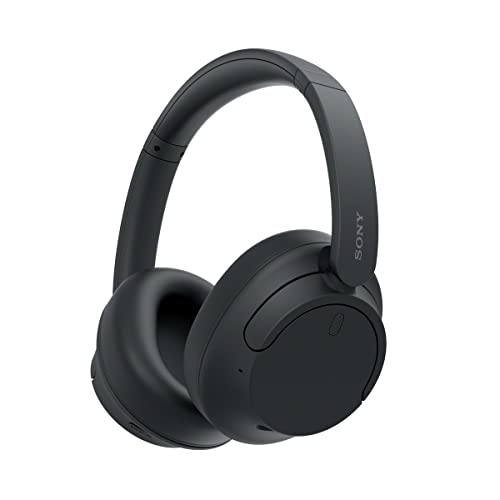
True 100W USB‑C PD, two USB‑C + USB‑A, and laptop‑level charging — with a couple of real‑world tradeoffs.
Battery panic is the worst kind of productivity killer — it always shows up at the worst moment: mid‑meeting, mid‑flight, or five minutes before a deadline. If you need a portable battery that can actually handle a laptop (not just your phone), the usual thin power banks won’t cut it.
Enter the Ugreen Power Bank 20000mAh 100W: a compact, three‑port pack that brings true 100W USB‑C PD to the palm of your hand. It reliably tops up MacBooks and fast‑charges phones, and while it’s not flawless (expect some efficiency and standby drain quirks and a bit of weight), it’s one of the easiest ways to carry real laptop power without hauling a brick.
Ugreen 20000mAh 100W Power Bank
A reliable, laptop-capable power bank that brings true 100W USB-C PD to a pocket-friendly 20,000mAh package. It’s ideal when you need real power for a MacBook or to top up multiple devices quickly, though power efficiency and standby drain aren’t industry-leading.
In-depth look: Ugreen 20000mAh 100W Portable Power Bank
If you’ve ever reached for a corner outlet in an airport and found none, this power bank aims to be the next-best thing: a compact battery that can keep a laptop awake, a phone happy, and earbuds humming. Ugreen’s 20,000mAh pack tries to bridge the gap between everyday portability and serious PD (Power Delivery) performance.
What this unit brings to the table
This device targets users who need more than a phone-topper but less than a suitcase-sized battery. It packs two USB-C ports (one capable of full 100W PD), a USB-A port for legacy devices, and support for fast-charging standards like PD and QC. Expect pragmatic design choices rather than flashy extras.
Ports, compatibility and real-world use cases
This power bank isn’t a one-trick pony. The port layout lets you run a laptop from the main USB-C, keep a phone topped up from the second USB-C, and charge accessories from the USB-A simultaneously. That versatility is what makes it practical for day trips, remote meetings, or plane travel without reliable power.
Typical charging times (real-world estimates)
| Device | Approx. Time to 50% (when empty) | Notes |
|---|---|---|
| iPhone (modern flagship) | ~15–30 minutes via 100W USB-C (phone limits apply) | Uses PD profile negotiated by the phone |
| MacBook Air (M1/M2) | ~30 minutes to 50% when using 100W PD | Useful for top-ups or short flights |
| iPad / Tablet | 30–60 minutes depending on model | Good for long sessions away from a wall charger |
| Gaming handhelds (Steam Deck / Legion Go) | 30–90 minutes depending on load | Can maintain battery under light usage; heavy gaming will deplete quicker |
Battery capacity vs. usable energy
A 20,000mAh rating is handy marketing shorthand, but chemistry and voltage conversion matter. Expect something less than the full rating once you factor in conversion losses (USB step-up/down) and device negotiation. Users report solid performance for several phone charges and emergency laptop top-ups, but don’t expect to run a heavy gaming laptop for hours.
Safety, thermals and charging etiquette
Ugreen includes the typical safety suite and thermal management, which keeps the unit reliable under normal use. When pushing high wattage (100W) heat is the inevitable tradeoff. Use short software-intensive sessions on laptops if you need maximum throughput for longer durations — or place the pack on a cool surface.
Design, handling and portability
Measured at roughly pocketable dimensions but around 420 g in weight, this pack sits in the “carry in a bag” category rather than “carry in a skinny pocket” territory. Its sculpted edges and matte finish resist fingerprints and give it a professional look that won’t scream “gadget” in a meeting.
What you’ll notice after several uses
Users generally praise fast charging and compatibility, while some report quicker-than-expected standby drops over several days of non-use. That means if you’re buying this for emergency prep, cycle it periodically. For daily commuters and travelers who charge frequently, it’s a dependable workhorse.
Accessories and in-box items
Verdict: who should buy this?
If you need a compact power bank that can actually feed a laptop and fast-charge smartphones at the same time, this is a practical, affordable option. Power users who want advanced telemetry (per-port wattage displays, time-to-empty) will miss those features, but most people will appreciate the mix of performance and size.
In short, this Ugreen unit balances serious PD power with portability and an everyday-friendly price — the kind of device that quietly keeps your devices alive while you get on with life (and maybe a coffee or two).

FAQ
Yes — the primary USB-C port supports up to 100W PD, which is sufficient to charge many MacBook Air/Pro models and other USB-C laptops for top-ups or light productivity use. Heavy-duty gaming laptops or those requiring >100W in sustained draw will either charge slowly or need a wall charger.
Expect multiple full charges for most modern smartphones — typically 2–4 full charges depending on phone battery size and real-world conversion loss. Tablets and laptops will get smaller percentage top-ups because they have much larger batteries.
You can charge multiple devices simultaneously, but total available power is shared. The 100W port will negotiate with devices and may reduce wattage when other ports are active. For best thermal and efficiency behavior, avoid sustained full-speed charging on all three ports at once.
Store it at around 40–60% charge in a cool, dry place. Avoid leaving it at 100% or 0% for months. Check and top it up every 3–6 months to maintain battery health.
For many devices, the PD 100W output approaches wall-charger speeds for short bursts, especially on phones and lighter laptops. However, wall chargers can sustain max wattage longer because they’re not limited by stored energy and heat constraints in a small battery pack.
Yes — the USB-A port supports conventional charging for older smartphones, headsets, and accessories. Expect standard speeds (not necessarily the same fast PD profiles as USB-C).
Most retail packs include a short USB-C cable and sometimes a soft carrying pouch, but inclusions may vary by region or seller. Check the product listing for the exact in-box contents.
Lower the laptop brightness, close heavy apps and background processes, and use power-saving profiles while charging from the bank. That reduces draw and stretches the usable energy for more useful top-ups.












Picked one up last month and it actually can top up my 13″ MacBook Pro from ~20% to ~80% while I work in a cafe. Feels solid in the hand and the two USB-C ports are handy when my phone also needs a boost.
Only downside is the standby drain — I noticed it loses a few percent if left unused for days. Still, for the price (189 AED) I think it’s great value for travelers who need real laptop power without lugging a brick.
A bit warm but not alarmingly so. I used it on my lap once and it was fine — maybe slightly warmer than a phone charger but not scorch-your-knee level.
Good to hear! Does it get hot when charging both the laptop and phone at the same time?
Thanks for sharing your real-world experience, Emily — helpful to know it reaches ~80% in a session. The standby drain was mentioned in the review as well; we’re trying to quantify it better in follow-ups.
Does anyone use this mainly for phones/tablets rather than laptops? I’m curious if the USB-A port is still useful or if everything is USB-C these days.
The included USB-A adds versatility for older gear or passengers who don’t have USB-C cables. But for fastest charging, use the USB-C PD ports.
I still use the USB-A for older accessories and a few cheap cables. It’s handy as a backup but most day-to-day charging I do via the two USB-C ports.
Interesting review. Quick question: has anyone measured how many full MacBook charges the 20,000mAh actually gives? The spec saying 100W PD is great, but I’m curious about real capacity after conversion losses.
Good point, Alex. The bank supports 100W but you need an appropriate cable and the laptop must accept PD at that wattage. We recommend using the included or a known-good 5A/100W cable.
Also remember cable quality matters — cheaper cables can limit PD speeds. Use a certified USB-C 100W cable.
From personal use: I got one full charge on a MacBook Air (M1) and a decent top-up on a Pro. Heavy workloads will reduce that noticeably.
Great question — due to conversion losses and voltage differences, you should expect roughly 40–60% of the rated mAh for laptop charging (so around 8,000–12,000mAh at 5V-equivalent). That usually equates to about one full charge for many 13″ laptops depending on usage.
As someone who frequently flies for work, this has been a lifesaver. Two things I appreciate:
– The passthrough charging when connected to mains + devices is pretty solid.
– The build feels durable; I’ve bumped it around in luggage and it’s fine.
Constructive note: battery indicator could be more precise (those 4 LEDs are kinda vague). Also, 189 AED is a decent price but shop around — sometimes you find sales. 🙂
Thanks for the traveler perspective, Hannah. We noted the LED indicator limitation in the review — more granular percentage readout would be nicer.
FYI, some users pair it with a cheap USB-C power meter to see exact draw. Not ideal but works in a pinch.
Good tip Liam. I tried a meter once — useful for diagnostics if you’re picky about efficiency.
We’re thinking about adding a quick-buy tracker in a follow-up post that compares current prices across merchants — might help readers get the best deal.
Agree on the LEDs. I wish there was an app or at least a digital display for exact %.
I’m torn — the size and weight (420 g) still make it fairly pocketable for jeans, but it’s not lightweight.
I travel a lot and care about efficiency and standby drain. A few concerns:
1) The review mentions standby drain — how bad is it? Does it lose charge over a weekend?
2) Any insight on long-term battery health? After 1 year does capacity drop significantly?
3) Is the product noisy or does it ever make clicking noises when charging?
Would appreciate any detailed feedback from owners. Thanks!
I had a minor issue with an older unit where the indicator LEDs flickered, but customer support handled it. Not common but worth keeping warranty in mind.
For travel I put power banks in carry-on and avoid extreme temps. That helps battery life a lot. No clicks here either.
One more tip: if you won’t use it for weeks, store it at ~40–60% charge to preserve longevity.
I left mine in a bag over a weekend and lost around 3–4% — not huge but noticeable. After ~8 months I haven’t seen dramatic capacity loss.
Thanks, Priya. We noted standby drain isn’t best-in-class — a few percent over several days is common. Long-term health depends on charge cycles and storage conditions; Ugreen units generally hold up well over 1–2 years with normal use. No clicking noises reported in our tests, just slight warmth.
100W in your pocket? Sure, and I have a pocket-sized coffee machine too 😏
Jokes aside, curious how ‘pocket-friendly’ it truly is. 420g is not light but I guess it’s better than a laptop charger.
I toss it in my backpack’s laptop sleeve and hardly notice it. Definitely more convenient than carrying the laptop charger around.
Ha — fair point. ‘Pocket-friendly’ is relative: it fits in larger coat pockets and many bags, but not small pant pockets comfortably. Compared to most 100W wall chargers + brick, it’s more convenient for on-the-go top-ups.